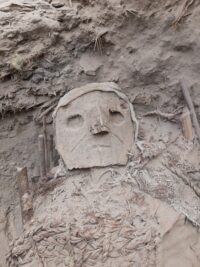
The burials were found in a complex of cemeteries from different periods at the foot of the Inca-era Painted Temple. The cemetery complex was first discovered in the late 19th century by German archaeologist Max Uhle. They had been widely damaged in the “extirpation of the idolatries” during the colonial period and would be repeatedly looted after Uhle’s excavation. The discovery of 73 undamaged burials is therefore of great archaeological significance.


The style of these staff is comparable to the famous cult image known as the ‘idol of Pachacámac’. This wooden carving depicts two deities standing on a high pedestal. Each of them looks towards the other like the Roman Janus, but the two figures are clearly joined back to back and each has a different character, i.e. a celestial aspect versus a telluric aspect, and are possibly also of different sexes. Stylistically, the idol is closer to the iconography known from the Castillo de Huarmey, among other places, than from the Wari religious centres at Ayacucho.

The results of the research to date indicate that during the Wari Empire period, specifically between 800 and 1100 AD, Pachacámac had the character of a settlement, with a ceremonial platform. This platform is currently hidden under the rubble and terraces of the Painted Temple from the Inca period. The cemetery uncovered by Professor Makowski’s excavations does not have the character of an elite necropolis as suggested by Uhle. It is instead comparable to the Ancón site, which was the burial place of fishermen, from the part of the coast between the Chancay and Chillón valleys both during the Wari Empire and in later periods.
Due to the state of preservation and the precision of the documentation of the context of the finds at the time of excavation, as well as the laboratory analyses, the burial assemblages uncovered are a veritable goldmine of information on the social position of men, women and children according to kinship ties, the care of invalids, indicators of war and domestic violence. Nineteen of the bundles, with their lower part preserved and an intact structure, could be transferred to the laboratory in their entirety in order to document them three-dimensionally using CT scanning without having to be opened.
* This article was originally published here











No comments:
Post a Comment